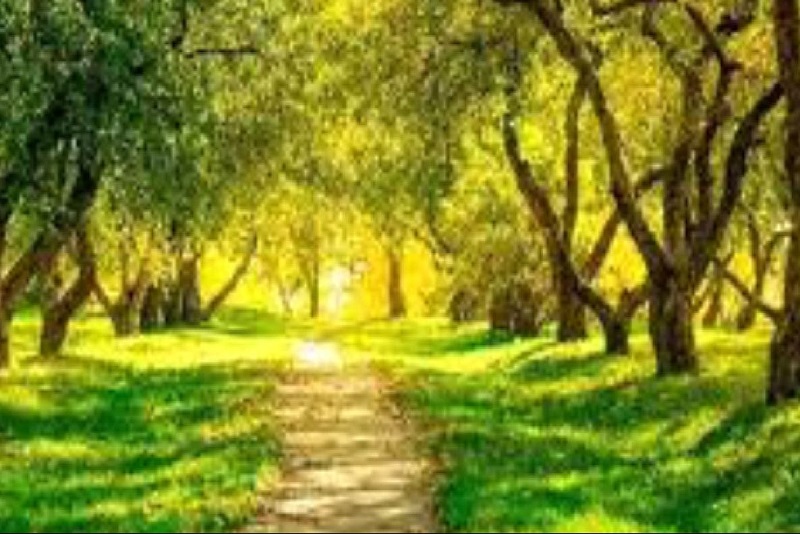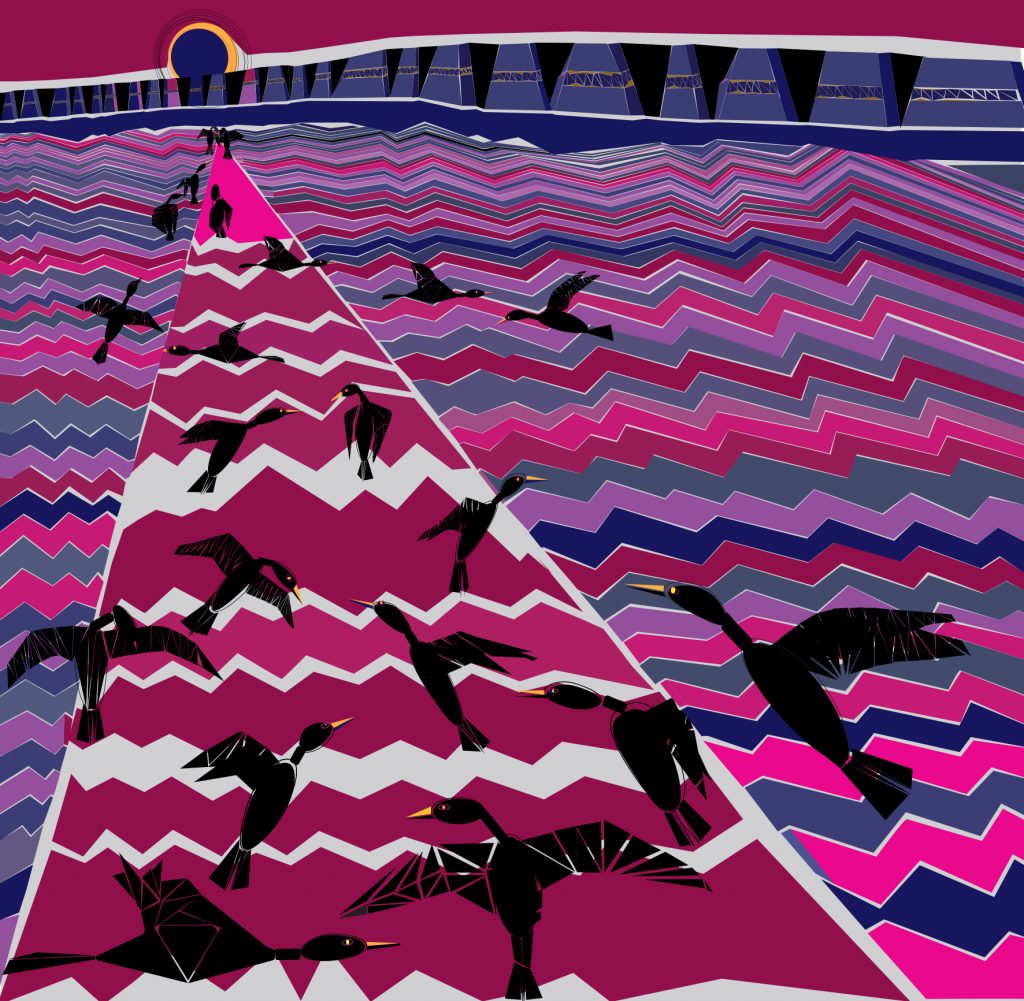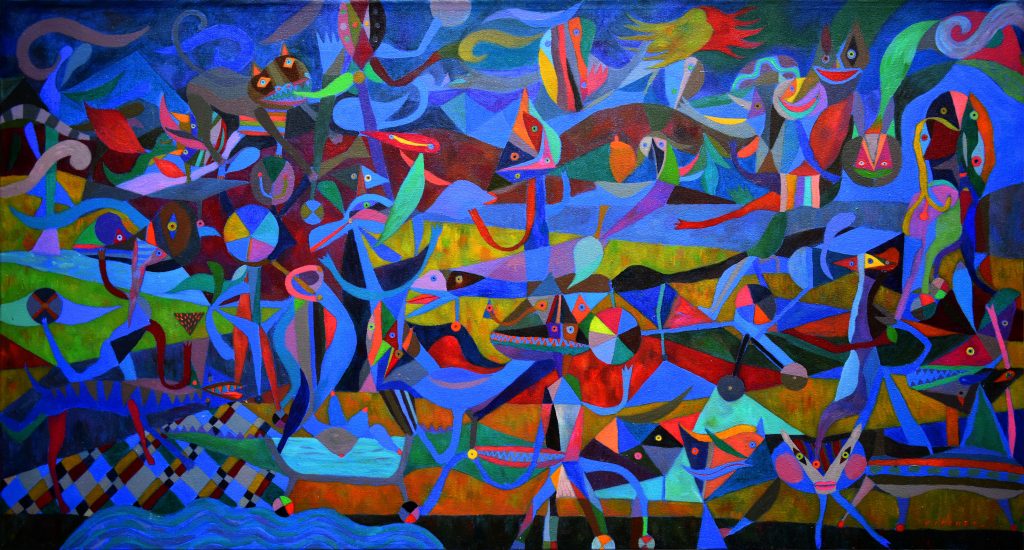
By Tony Darrington
“Art in the Park” is usually a winner: a stroll through Central Park before a Sunday visit to the Metropolitan Museum in New York. In London, a jog across Hyde Park before entering the annually-changing Serpentine Gallery and in Lima’s San Isidro it’s a quick hop through the ancient olive groves — some 400 years in antiquity — which constitute the Bosque El Olivar. You can walk in minutes from the long-established sculpture gallery at the Museo Marina Núñez del Prado to the temporary exhibitions at the El Olivar Gallery in the basement of the Centro Cultural El Olivar.
The current exhibition is titled LA VANGUARDIA DE LAS FORMAS: Homenaje de la Bauhaus. Curated by Paola Denegri, it is a showcase for the multi-disciplinary collective “Arte Sana” (Artesana in some references) by contemporary Peruvian artists and renders homage to the German Bauhaus movement and institution in its centenary year (forgetting the Nazi-induced closure of 1933 to 1945). We now know that the Bauhaus ideals did not spring out of nowhere nor was it just the inspiration of the period 1919 to 1933 or the synergy of a geographical concentration of multi-talented artists and artisans.

The arts and crafts movement — a critique of industrial mass-production — was one source of inspiration whereas what was then called primitivism was another. The extraordinary collections (see note) of ancient Andean textiles in the Museen für Völkerkunde (the German ethnological museums) were already on hand for the workshops run by Anni Albers in the search for simplicity and honesty as well as the attainment of exceptional expertise and innovation with stitch and weave in the case of textiles. Dr Virginia Gardner puts it like this in her seminal article “Anni Albers and ancient American textiles.”
“Her (Anni Albers) basic premise — formed when she was a student of the Bauhaus, and still highly relevant today — was that modern textile workers, both in industry and in art, should thoroughly study the forms and structures of Andean textiles because these textiles represent “a standard of achievement that is unsurpassed” in the field of textile design and production.”
The burial practices of the ancient Mochica, the Paracas, the Nasca and the Wari cultures, the preservation climate of the Peruvian desert, huaqueros (tomb-raiders), European collectors in the Andean countries, the German Ethnological Museum, the Bauhaus and Anni Albers all acted as a conduit for knowledge about — if not the actual objects — these awesome past achievements by pre-hispanic cultures (especially in Andean textile weaving and embroidery) up and into the present day.
For the artists Milagros Bellido, Teresa Carvallo, Mariano Li-Carrillo, Ximena Maurial, María Isabel Scheuch, Paula Denegri (also curator), Natalia Tarnawiecki and Francisco Vilchez, the influence of the Bauhaus was sufficiently strong for the collective to mount this exhibition as a homage. Wisely the gallery has not been crowded with exhibits and the quality is extremely good. It is to be hoped that a permanent exhibition site can be found for at least some of them. And an Andean/ Peruvian element is visible in some of the exhibits (as in Paula Denegri’s “Costa Verde” above).

Anni Alberts and the influence of Andean textiles
A roll-call of the Bauhaus great is inscribed on the gallery wall and includes Gropius, Paul Klee and Josef Albers but not, it seems, (unless I was mistaken) Anni Albers. The channels of influence in artistic movements are only partly intellectual, partly museum-driven (if at all). Albers’s interest was in textiles and this exhibition’s artists is in other materials. The influence of the Bauhaus in the formation of an international modernism is undeniable and it does seem that Peruvian textiles (mainly) together with the Arts and Crafts movement have played a significant role.
Major donations of Andean art to the museum include the Baessler donation of 11,690 items in 1899; the Reiss and Stübel donation of 2,000 items in 1879. The museum acquired 2,400 items in 1882 from Dr. José Mariano Macedo of Lima, and subsequently the large Centeno collection, from Cuzco, in 1888, and the Bolivar collection in 1904. Wilhelm Gretzer sold 27,254 ancient American pieces to the museum in 1907; Corinna Raddatz: “Christian Theodor Wilhelm Gretzer and his Pre-Columbian Collection in the Niedersächsisches Landesmuseum of Hannover,” in: Hocquenghem, pp. 163–16. (Source: Virginia Gardner Troy http://www.bauhaus-imaginista.org/articles/771/anni-albers-and-ancient-american-textiles).
Postscript. Susie, my wife, and I set out to visit, a decade or so ago, the Hannover and Berlin museums with the specific aim to view these Andean textiles. The Berlin Ethnological Museum had moved to Dahlem (since 1909!). Our hire car was pre-satnav and without conventional maps and once in or near to Dahlem very few pedestrians knew of the museum. Who should we ask? Business types clad in suits or hippy student types hardly clad at all (it was a furiously hot summer’s day), none came up trumps. We drove around in circles and arrived late in the afternoon.The only curator or specialist available could show us just three of the assumed thousands in their collections. At this stage, grown archaeologists had been known to cry —few of the textiles have detailed provenance. Since then there have been some notable returns of textiles and other artifacts to Peru. The return of the Paracas textiles from Gothenburg, Sweden is better known.
Note. For example, by 1907 the Andean art collection at the Berlin Museum für Völkerkunde was enormous; the textile collection alone exceeded 7500 pieces, by far the largest collection of Andean textiles in Europe at the time. See Immina von Schuler-Schömig: “The Central Andean Collections at the Museum für Völkerkunde, Berlin, Their Origin and Present Organization,” in: Anne-Marie Hocquenghem (ed.): Pre-Columbian Collections in European Museums, Akademiai Kiado, Budapest 1987, pp. 169–175.
WHERE: Centro Cultural El Olivar, Calle La Republica 455, San Isidro.
WHEN: Until September 15, 2019. Open Mon-Sun 10am to 8pm.






Tony Darington and the Peruvian Times. Thanks a lot for your review.
It made me feel accomplished by the mentioned lnfluence on my piece, La Costa Verde, of Peruvian textiles.
Thanks a lot.